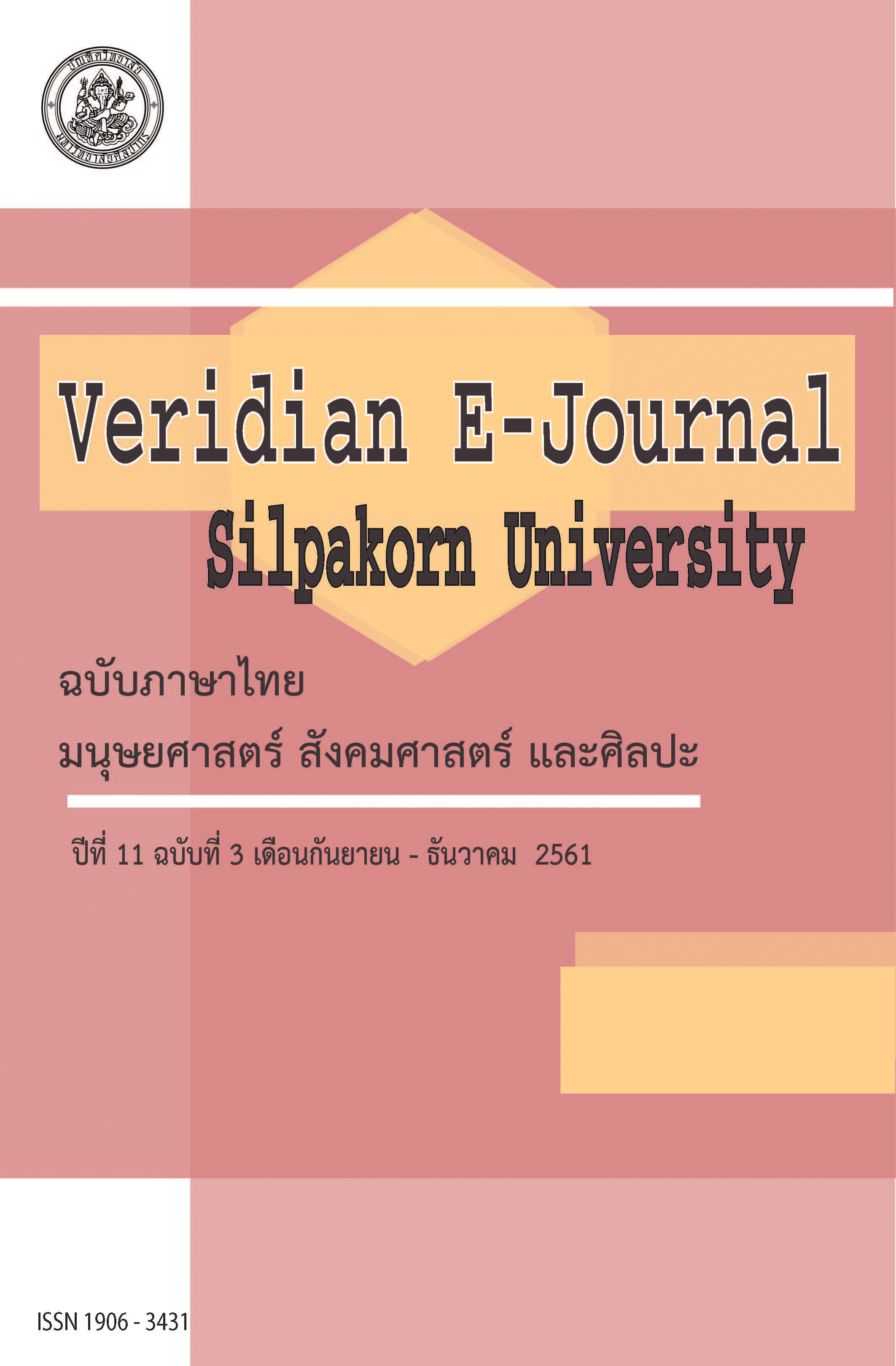การจัดการแบบมีส่วนร่วมของชุมชนเพื่อพัฒนาการท่องเที่ยวเชิงวัฒนธรรมของ กลุ่มชาติพันธุ์มอญ ตำบลบางขันหมาก อำเภอเมือง จังหวัดลพบุรี (Management by Community’s Participation for Developing Cultural Tourism of Mon Ethnic Group in Bang Khan Mak Sub- District, Muang District, Lop Buri Province)
Main Article Content
Abstract
การวิจัยครั้งนี้มีวัตถุประสงค์เพื่อ 1) ศึกษาสภาพปัจจุบันและปัญหาด้านการจัดการท่องเที่ยวเชิงวัฒนธรรมของกลุ่มชาติพันธุ์มอญ ตำบลบางขันหมาก อำเภอเมือง จังหวัดลพบุรี 2) ศึกษาระดับการมีส่วนร่วมในการจัดการท่องเที่ยวเชิงวัฒนธรรมของกลุ่มชาติพันธุ์มอญ ตำบลบางขันหมาก อำเภอเมือง จังหวัดลพบุรี และ3) ศึกษาแนวทางการพัฒนาการท่องเที่ยวเชิงวัฒนธรรมแบบมีส่วนร่วมของชุมชนกลุ่มชาติพันธุ์มอญ ตำบลบางขันหมาก อำเภอเมือง จังหวัดลพบุรี กลุ่มตัวอย่าง ได้แก่ 1) ผู้บริหารหน่วยงานและนักวิชาการ จำนวน 9 คน สุ่มตัวอย่างแบบเจาะจง 2) ผู้นำชุมชนจำนวน 14 คน สุ่มตัวอย่างแบบเจาะจง และ3) ประชาชนเชื้อสายมอญที่อาศัยในพื้นที่ที่ศึกษา จำนวน 400 คน สุ่มตัวอย่างแบบโควต้า การวิจัยครั้งนี้เป็นการวิจัยเชิงปริมาณและคุณภาพเน้นการวิจัยแบบมีส่วนร่วม เทคนิคที่ใช้ในการเก็บรวบรวมข้อมูล ได้แก่ การศึกษาค้นคว้าจากเอกสาร การสังเกต การสัมภาษณ์เชิงลึก การสนทนากลุ่ม การใช้แบบสอบถาม และการทำเวทีชุมชน วิเคราะห์ข้อมูลเชิงปริมาณโดยใช้สถิติร้อยละ และค่าเฉลี่ย ส่วนข้อมูลเชิงคุณภาพใช้การวิเคราะห์เนื้อหา
ผลการวิจัยพบว่า ปัจจุบันชาวมอญในตำบลบางขันหมาก ยังมีความโดดเด่นในเรื่องประเพณี ความเชื่อ และการละเล่นต่างๆ ที่เป็นเอกลักษณ์ของชาวมอญ แต่การสืบทอดวัฒนธรรมทางภาษา และวัฒนธรรมต่างๆ ที่เป็นเอกลักษณ์ของชาวมอญให้แก่คนรุ่นหลังน้อยลง การจัดการท่องเที่ยวเชิงวัฒนธรรมของชาวมอญตำบลบางขันหมากมีปัญหาหลายประการ ได้แก่ ยังไม่มีพิพิธภัณฑ์ การขาดมัคคุเทศก์ การเข้าถึงแหล่งท่องเที่ยวไม่สะดวก ความร่วมมือของผู้นำชุมชนและของประชาชนยังไม่มากพอ รวมทั้งการขาดแคลนงบประมาณและการสนับสนุนจากภาครัฐ สำหรับแนวทางการจัดการพัฒนาแหล่งท่องเที่ยวเชิงวัฒนธรรมของกลุ่มชาติพันธุ์มอญ ตำบลบางขันหมาก จังหวัดลพบุรี ควรมีการจัดตั้งพิพิธภัณฑ์ท้องถิ่นแสดงวิถีชีวิตและภูมิปัญญาชาวบ้าน อบรมผู้นำชุมชนเพื่อสร้างการมีส่วนร่วมในชุมชนอย่างทั่วถึง ปรับปรุงการประชาสัมพันธ์ สิ่งอำนวยความสะดวก และการเข้าถึงแหล่งท่องเที่ยวให้เป็นที่พึงพอใจของนักท่องเที่ยวมากยิ่งขึ้น
The purposes of this research were to :1) study the state and problems of the cultural tourism management by the participation of Mon Ethnic Group, Bang Khan Mak Sub-district, Muang District, Lop Buri Province; 2) study the level of participation for managing the cultural tourism management of Mon Ethnic Group at Bang Khan Mak Sub-district; and 3) study the guidelines for the cultural tourism management by the participation of Mon Ethnic Group at Bang Khan Mak Sub-district. The samples were 9 organizational administrators and academic staff, and 14 community leaders, drawn by purposive sampling, 400 residents in the studied area, selected by qoata sampling. The Mixed Method Research (MMR) including documentary review, observation, in-depth interview, questionnaires, and focus group technique, was employed for data collection. The quantitative data were systematically analyzed by percentage and mean, and the qualitative data were analyzed by content analysis. The finding showed that Mon Ethnic Group at Bang Khan Mak Sub-district still preserved the outstanding identities: traditions, beliefs, and entertainments. However, the next generation of Mon Ethnic Group, Bang Khan Mak Sub-district was less of inheritability in speaking Mon’s language and some other cultures. The cultural tourism management by the participation of Mon Ethnic Group at Bang Khan Mak Sub-district faced many problems: no museum, lack of tour guides, inconvenience of accessing attractions, not enough participation of community leaders and people, lack of fund, and lack of supporting budgets from the government. The guidelines for the cultural tourism management by the participation of Mon Ethnic Group at Bang Khan Mak Sub-district should be : 1) establishing local museum to show ways of life and folk wisdom of Mon Ethnic Group, 2) conducting training program for motivating community leaders and residents to participate in the cultural tourism management, 3) improving the channels of public relations, 4) improving places and facilities for tourists, and 5) figuring out ways to access attractions.
